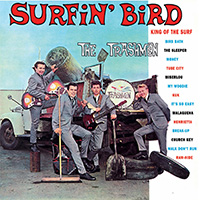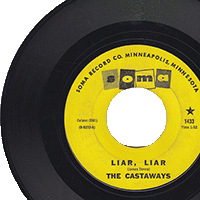Vic’s
507 Hennepin Ave.
Minneapolis
This page concerns the many, many dining and dancing establishments located at 507 Hennepin Ave., in the Hale Block at 5th and Hennepin in Downtown Minneapolis. For the history of that building, click here.
This is where the action was. For some reason, this address turned over – and over – and over – and was the location of the entertainment mecca of the Hale Block. Now, tracing the inhabitants of 507 Hennepin Ave. is a bit tricky, because that address might have been kind of fluid. A search through the newspapers yielded conflicting information:
- June 1880: Dyer & Howard was an early music store that sold sheet music, pianos and organs, and small musical instruments.
- 1894: Drug Store
- 1899: Wheeler and Wilson Sewing Machine Co.
- 1913: Saloon
- 1921: At the time of a big fire, three businesses were listed at this address: Silverman’s Grocery Store, Booth Fisheries, and Flood’s Market House.
- After the fire it was the Wholesale Candy Co., according to the ad below.
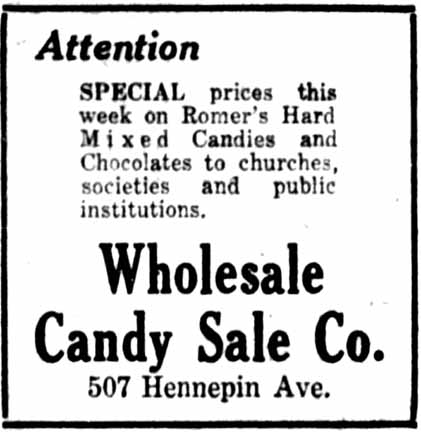
Minneapolis Tribune, December 14, 1921
- 1924: Warner & Co. Men’s Furnishings
- December 1928: The Cave, Abraham Bloom
- September 1929: Cafeteria
THE GROTTO
The Grotto featured the Grotto Cafe Orchestra, led by Sammy Scheiner, which broadcast over WRRM Radio. It operated from about March to December 1930.
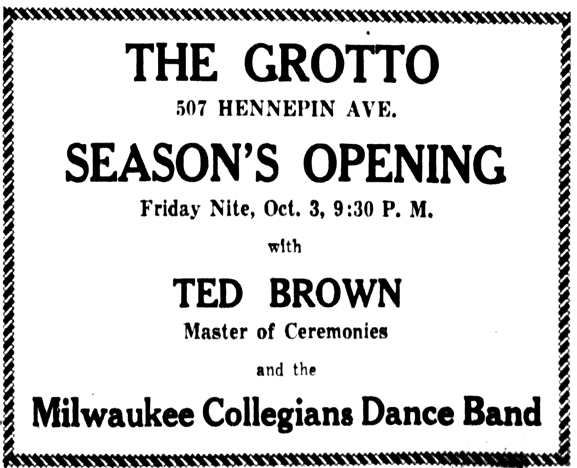
Minneapolis Tribune, October 11, 1930
NEW ENTERTAINERS’ CAFE
This enterprise apparently had one big New Years’ Eve blowout and disappeared.

Minneapolis Tribune, December 27, 1930
PORTAL PLAYERS CAFE
The Portal Players Cafe was a kind of dinner theater that presented religious plays. It was around from about October 28, 1931, to April 1932.
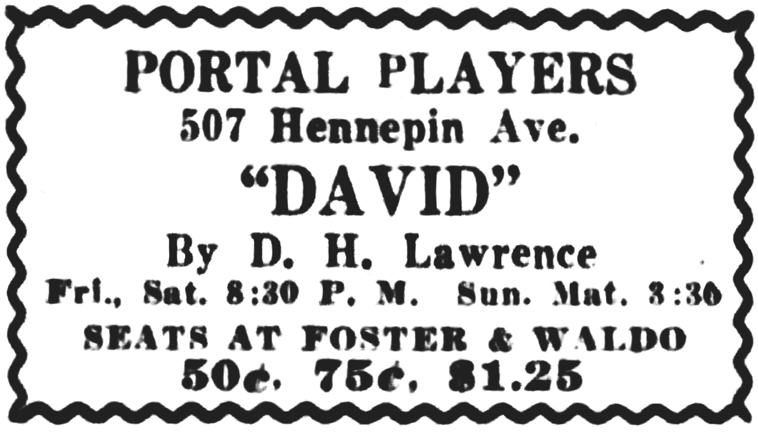
Minneapolis Tribune, November 27, 1931
THE COPPER KETTLE
Al Winger was the manager of the Copper Kettle, which was apparently just a restaurant that also served “real drinks.” These ads were the only evidence of its existence, however.

Minneapolis Star, January 27, 1933
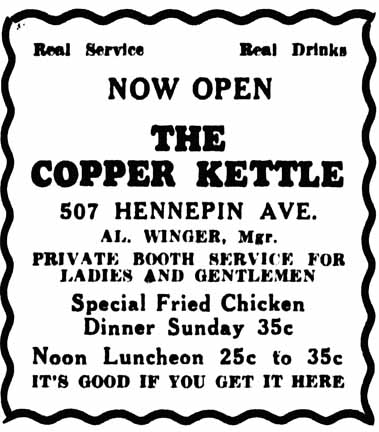
Minneapolis Star, February 4, 1933
THE HARBOR BAR
Andy Leonard got a liquor license on January 14, 1934, and started the Harbor Bar/Cafe. It apparently coexisted with other clubs.
THE CLUB LIDO
The ad below tells us that the Club Lido opened on August 14, 1935.
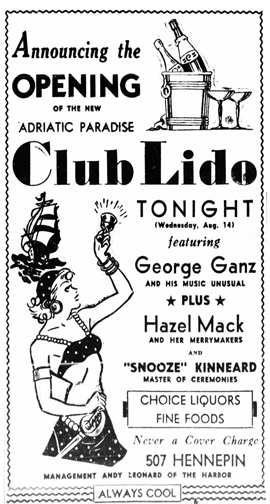
Minneapolis Tribune, August 14, 1935
Owner Andrew Leonard was jailed in February 1936 for selling liquor after hours and fined $75.
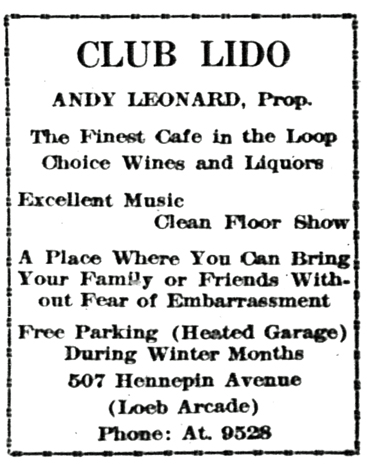
Saturday Press, December 1935
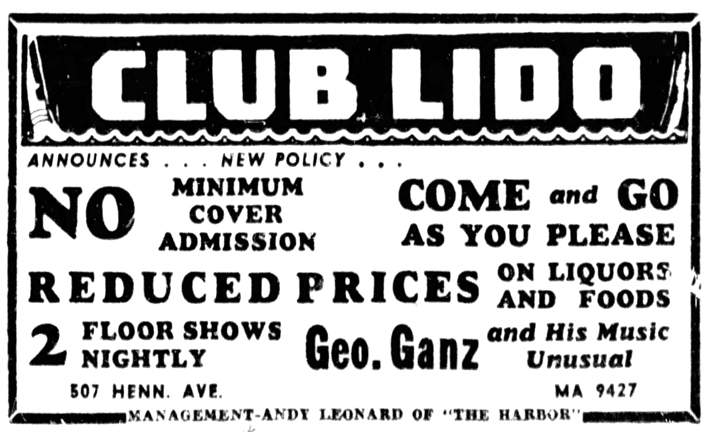
Minneapolis Tribune, January 18, 1936
OLSON’S HARBOR BAR
Howard C. Olson did 90 days in the Workhouse for serving liquor on a Sunday in November 1942. The Liquor license was revoked in January 1943.
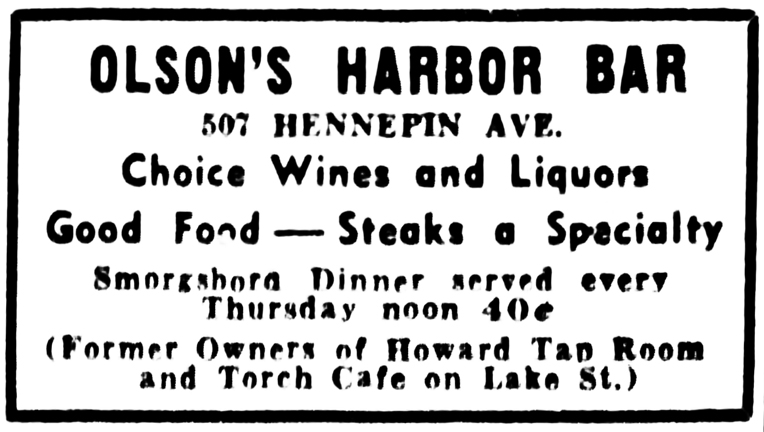
Minneapolis Tribune, March 8, 1940
DOME THEATER LOUNGE
The Dome opened on March 31, 1943, by Vic Levine, Sr. It featured mainly small, national jazz groups such as Henry “Red” Allen, Johnny “Scat” Davis, and Red Reynolds.
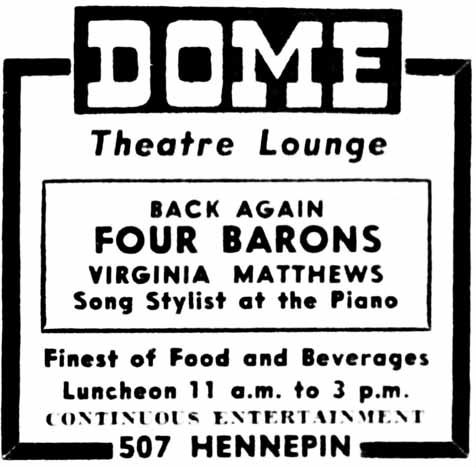
Minneapolis Tribune, January 21, 1944
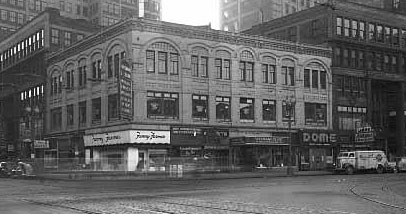
The Hale Block in 1946, with the Dome at far right. Photo courtesy Minnesota Historical Society
The matchbooks below are courtesy of the collection of Mark Youngblood.
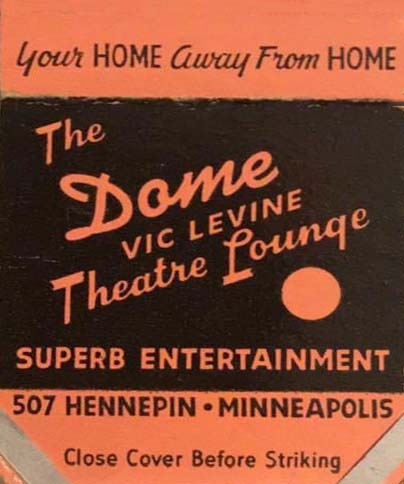
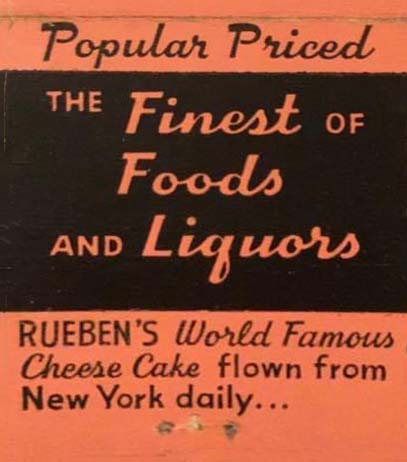
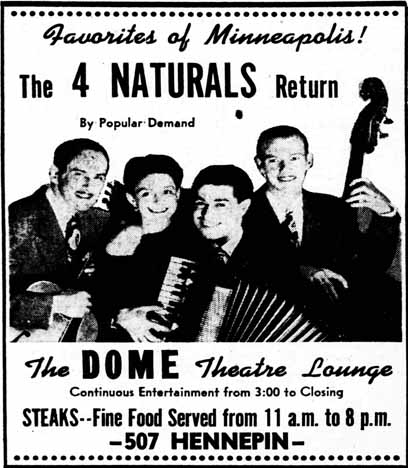
Minneapolis Star, May 2, 1946
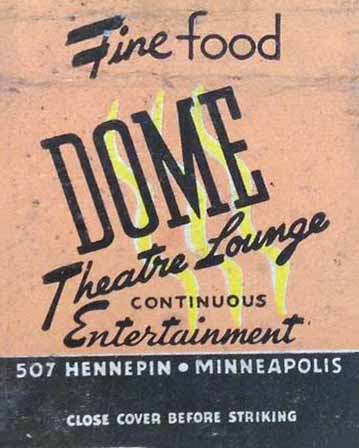
From the collection of Mark Youngblood

From the collection of Mark Youngblood
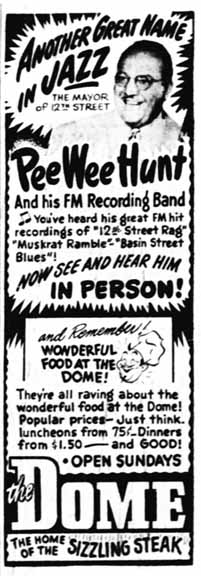
Minneapolis Tribune, February 18, 1949
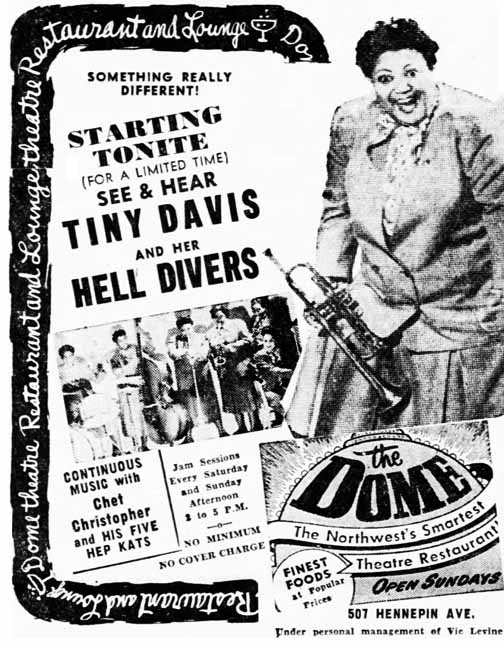
Minneapolis Tribune, January 30, 1950
Matchbook images below courtesy Gordon K. Andersen
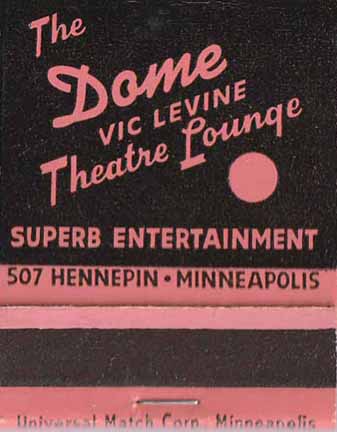
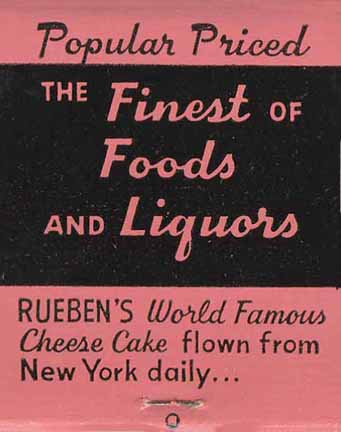
VIC’S
Vic sold the Dome in December 1950, but he bought it back in August 1951 and in October 1951 the club was reopened as Vic’s. Bob Davis’s Trio appeared at Vic’s from 1951 to 1957. In October 1952 the ad featured six acts, performing four shows nightly. “The best in the west!”
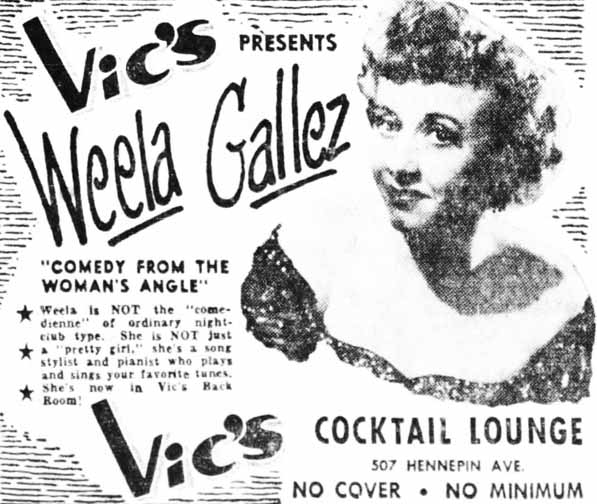
Minneapolis Star, March 11, 1953
JAZZ AT VIC’S
In the early 1950s, Vic’s hosted the best of jazz artists. Dig that “Royal Court of Jazz! Irv Williams on sax and Ira Pettiford (that’s a typo on the ad) on bass.
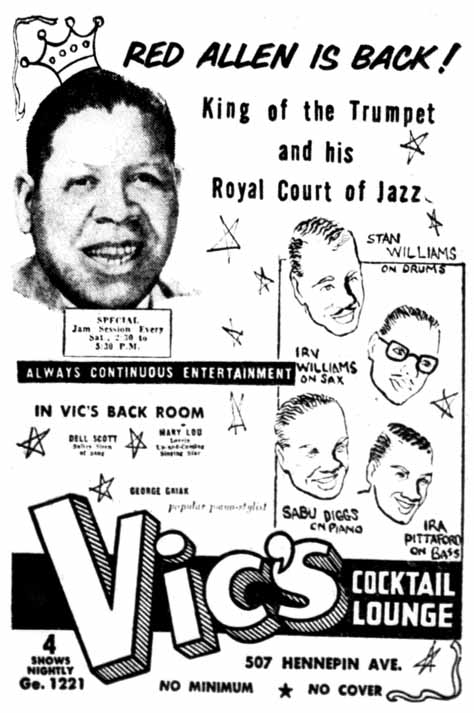
Minneapolis Tribune, January 27, 1954
Vic’s started advertising jazz performances in the Minneapolis Spokesman in April 1954, with Red Allen, “King of the Trumpet and his Royal Court of Jazz.” Later in 1954 Vic held a fabulous Festival of Jazz, with:
- “Wild Bill” Boone and His Famous Quartet
- Tommy “Madman” Jones and His Jazz Combo
- Lester Young “The Prez”
- James Moody
- Earl Bostic
- Big Jay McNeely
- Illinois Jacquet
- Joe Houston and His Jazz Combo
- Bill Doggett
Minneapolis Spokesman: “Hear the Twin Cities’ Finest Musicians.”
THE HALE BLOCK BURNS DOWN
On October 25, 1954, a spectacular fire swept through the original 1880 Hale Block, totally destroying the three-story building. Ten businesses were destroyed:
- Vic’s Restaurant and Cocktail Lounge, 507 Hennepin
- Foreman & Clark men’s clothing store
- Fanny Farmer Candy shop
- New West Shoe Repair shop
- Sunshine Florists, 503 Hennepin
- Arcade Men’s shop
- Loeb Luncheonette
- Twin City Loan Co.
- McGlynn Bakery
Big Jay McNeely’s band, which had been knockin’ ’em dead at Vic’s since at least May 1954, suffered an $8,000 loss in instruments and about 30 suits. A.B. Cassius headed a committee that held a benefit dance for McNeely on November 7, 1954, at the Labor Temple “so that they can get back to their homes and maybe a down payment on some new instruments.’” reported the Minneapolis Spokesman. “Hear the Twin Cities’ Finest Musicians.” The origin of the fire was traced to orchestra’s dressing room in the basement of Vic’s. Although arson inspectors attempted to determine the cause of the fire, the basement was so full of water and debris that an inspection was too dangerous. (Minneapolis Star and Tribune, October 26, 1954) At the time it was characterized as the year’s worst fire, causing damage estimated at $750,000.
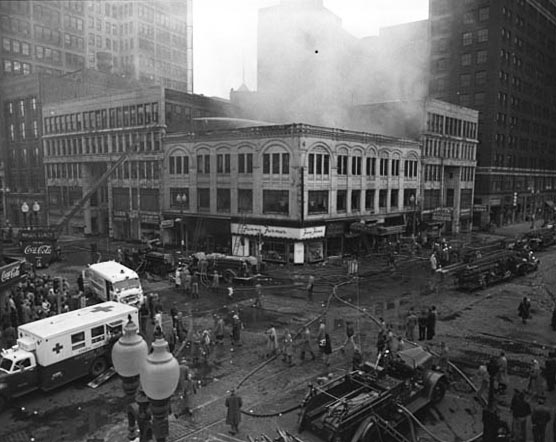
Hale Block fire – photo courtesy Minnesota Historical Society
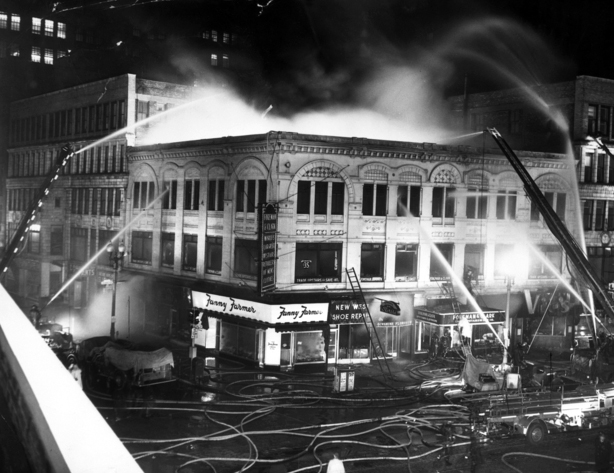
Hale Block fire – photo courtesy Minnesota Historical Society
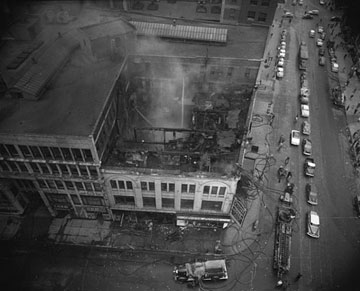
Hale Block fire – photo courtesy Minnesota Historical Society
THE NEW HALE BLOCK
(It wasn’t called that anymore, but I like the name) On the day after the fire, city building inspector Donald Erickson ruled that the owners of the building would not be able to reconstruct it, although the outside walls were still standing, because more than 60 percent of the building was destroyed. (Minneapolis Star, October 26, 1954) The old building was demolished (wrecking permit January 25, 1955). A building permit was approved to build a replacement building on April 25, 1955, in the same spot as the old one. The dimensions of this building were 83’ x 87’, and despite all those plans over the years to replace the Hale Block with a ten-story building, the replacement for the three-story structure was only two stories high. (It would have been three stories if NSP wanted the space.) The architect was Charles Hausler. This building stood on the corner for many years, anchored by Fannie Farmer.
MEANWHILE, BACK AT VIC’S
Vic’s temporarily moved to 314 Hennepin Ave. until the Hale Block was rebuilt. This location at 314 had formerly been Smitty’s Bar, which had had its license revoked in 1952 when a man picked up an 18-year-old girl there and then murdered her in a Skid Row hotel. It had been vacant ever since. (Minneapolis Tribune, December 9, 1954) A big ad in October 1955 announced that Vic’s was back at 507 Hennepin, and featured Lombardi’s Italian food.
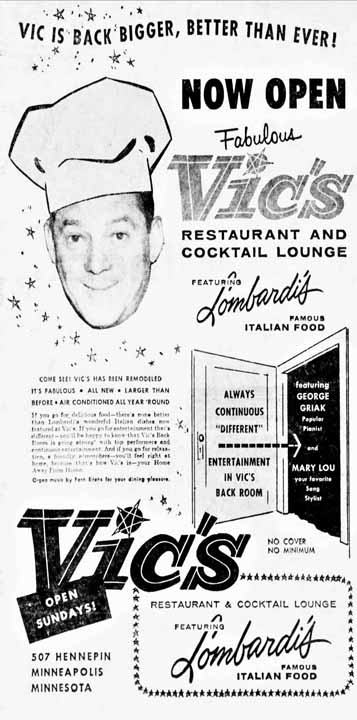
Minneapolis Tribune, October 21, 1955
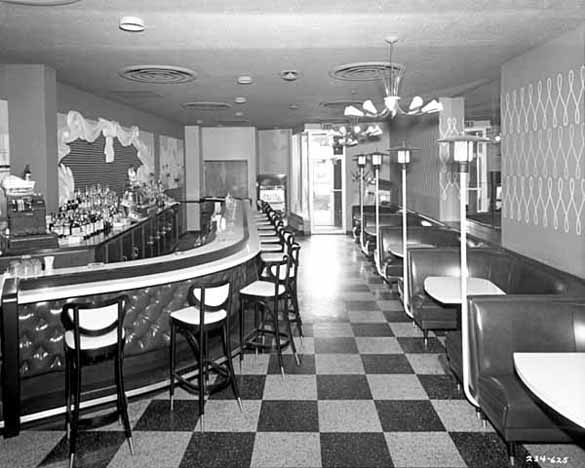
Vic’s in 1955. Photo courtesy Minnesota Historical Society
Other fun facts about Vic: Vic was famous for introducing cheesecake to our fair city, flying it in from Reuben’s in New York daily.
Vic later became a salesman of the Whisp, which was a pressurized spray bottle full of Vermouth for the making of the perfect martini.
OSTERBERG’S SUPPER CLUB
On December 20, 1956, Wilbur C. Osterburg bought the club and the adjacent restaurant, Tiny’s, to create Osterburg’s Supper Club. Osterburg was the president of Peters Oldsmobile, St. Paul. The club opened in April 1957. At first, he dropped the jazz entertainment that had been popular at Vic’s.
It operated as a jazz venue from about February 1957 to 1961. The first show was Slapsie Maxie Rosenbloom, from May 6 through 24, 1957. Rosenbloom was a former boxer-turned comedian. The show also featured girl singer Kitty Muldoon, described by Will Jones as “a red-tinted blonde with sparkly teeth.” Although she supposedly worked two days on an Elvis movie – and was dating E at the time – she does not, unfortunately, show up on imdb.com. Also appearing was Keith Gam’s band, with M.C. Bob Franzen.
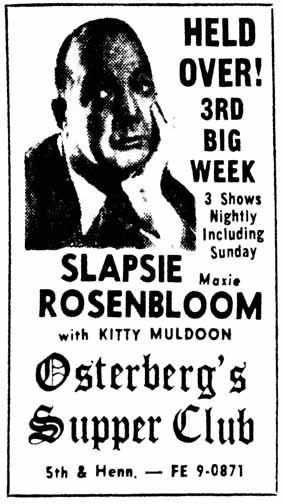
Minneapolis Tribune, May 23, 1957
Rosenbloom was initially hired for the week of May 6 – 12, 1957, but was held over until at least May 24. By May 30, he must have been gone, and Kitty was working solo.

Minneapolis Star, May 30, 1957
By May 27, 1957, Will Osterberg was advertising for a buyer or a full-time manager. He must have found the latter, because the establishment retained his name.
Jazz was back by 1958. A large ad called it “The Most Active, Exciting Nite Spot in the Twin Cities” It denoted “4 Different Rooms to Entertain You:”
- Front Room: Meet your friends here for conversation & companionship.
- Piano Room: Johnny Robertson’s piano styling for group singing.
- Stage Room: Features the prettiest girls from New York to Hollywood.
- Venetian Room: For dining and dancing to Ronnie Neuman’s Orchestra.
“Outstanding Entertainment, Delicious Food, Jazz, Latin-American, and Mood Music, Dancing and Atmosphere You’ll Love.” You could even get a buffet dinner for $1.25 – until 7 pm, at least. (Minneapolis Tribune, January 4, 1958)
Despite the ad below, the Bob Davis Quartet had a fairly long run until they broke up.
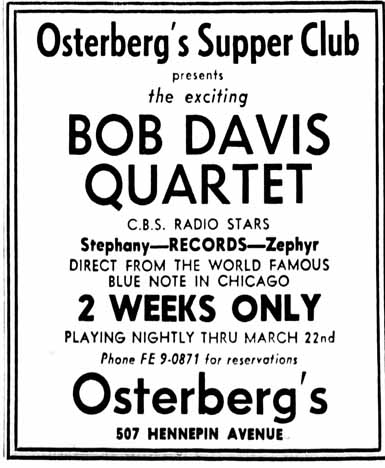
Minneapolis Tribune, March 12, 1958
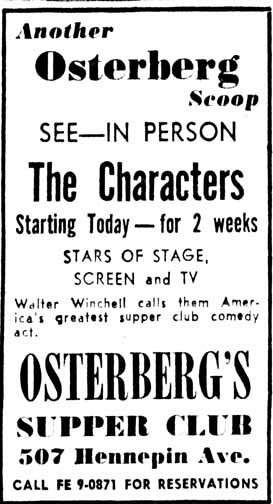
Minneapolis Tribune, April 7, 1958
In April 1959 the club was offering a 20 percent discount coupon in the paper. In February 1960, a report of a robbery revealed that the manager was Fred Wayman. In 1966 Osterberg was operating the Hillside Supper Club in Alexandria, Minnesota.
JOCKEY CLUB By New Year’s Eve 1960, Osterberg’s had become the Jockey Club. The liquor license was in the name of Leah Rackner, Richard Gold’s mother-in-law. The Jockey Club started out as a Dixieland joint in late 1960 and early 1961…

Minneapolis Star, December 23, 1960
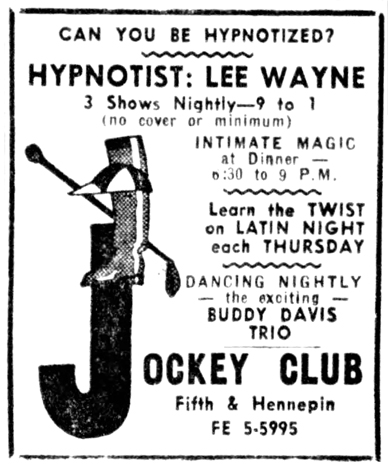
Minneapolis Star, February 22, 1962
SHARI FARRIS Shari Farris was more of a smooth song stylist, not exactly associated with the Twist, but she may have worked the transition or at a piano bar. Another ad says she was still at the Jockey Club on March 22, 1962.

Minneapolis Tribune, February 28, 1962
1962 AND THE TWIST!!
1962 was the Year of the Twist, and here the Jockey Club gives the date when it succumbed to the New All Girl Twist Review Policy – June 26, 1962. These ads came from the Minneapolis Daily Herald, a newspaper that tried to pick up the slack when the Star and Tribune were out on strike in the summer of ’62.
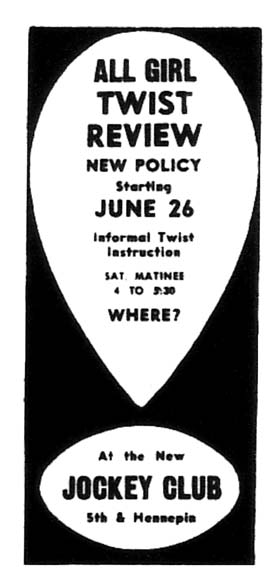
Minneapolis Daily Herald, 1962
Another ad from the Minneapolis Daily Herald revealed that the All-Girl Twist Review featured Nikki Cartwright, direct from the Broadway hit, “The Unsinkable Molly Brown;” Christine Joan, “Europe’s Enchanting Twistress;” and the Precisions, from Chicago’s Peppermint Lounge. (June 27, 1962)
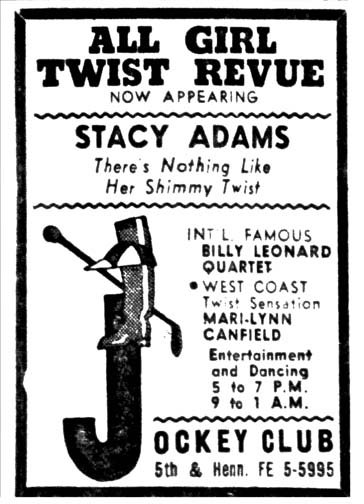
August 16, 1962
THE NITE BEATS: 1962 The ad and photos below are from Gary Myers: I was with the Night Beats (actually from Florida, booking out of Milwaukee, but I guess whoever did the ad thought Chicago sounded more impressive), playing there from August 20 to September 1, 1962. The photo of me was on my 20th birthday, singing “Runaround Sue.” (For a while I tried standing at the drums whenever I sang.)
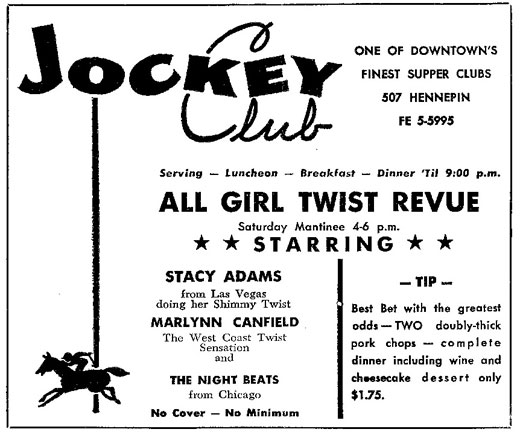
Ad courtesy Gary Myers
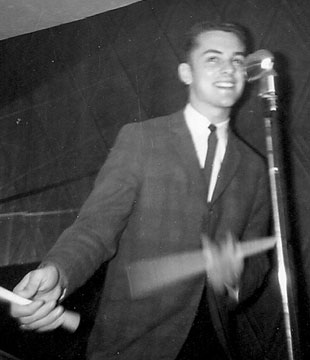
Photo courtesy Gary Myers
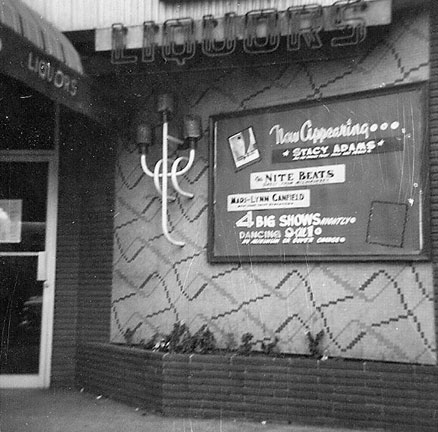
Photo courtesy Gary Myers
Following Gary and the boys was the Twist-A-Rama USA!
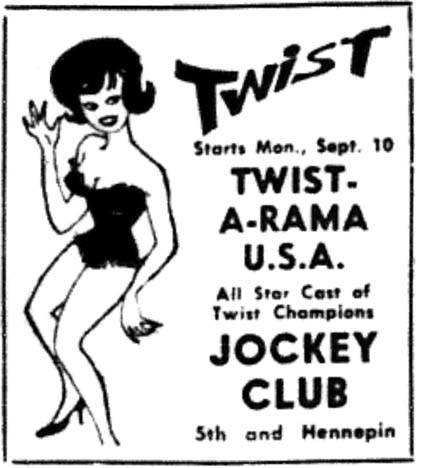
Minneapolis Daily Herald, 1962
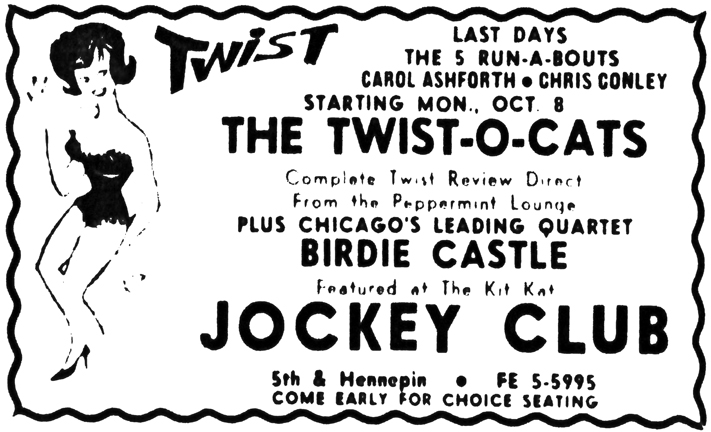
Minneapolis Star, October 5, 1962
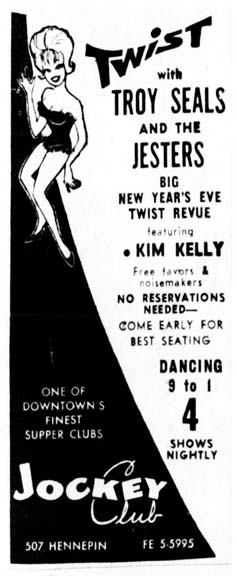
December 31, 1962
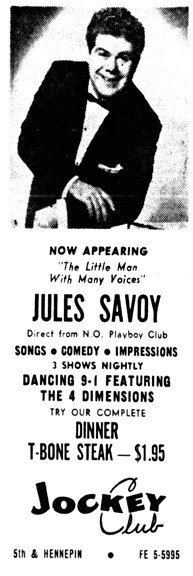
Minneapolis Tribune, January 19, 1963

Minneapolis Tribune, February13, 1963
Below is the last ad I found. The “Crystals” aren’t the Crystals at all, but the backup group for Gary Criss. Gary was in a group called the Glass Bottle, which sang “I Ain’t Got Time Anymore” in 1972 that probably only I remember. Kitty Randell doesn’t show up anywhere.
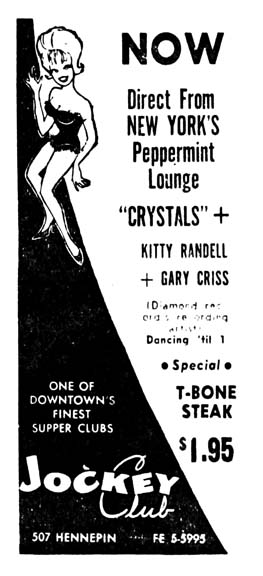
Minneapolis Star, April 19, 1963
A June 1963 ad described a racetrack decor with the accent on fun and excitement, with Dixieland music and dancing nightly. The Jockey Club ran its last race in September 1963.
ROARING TWENTIES On May 1, 1964, the club became the Roaring Twenties Lounge with Doc Evans’ Dixieland Band providing the music. In 1969 the band was the Norm Berger Orchestra.

Ashtray from the collection of Mark Youngblood
Matchbook below from the collection of Mark Youngblood:
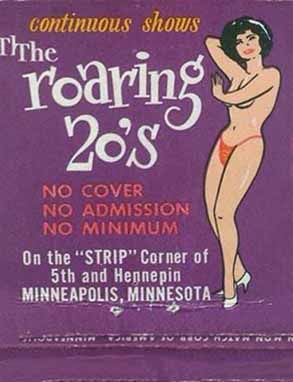
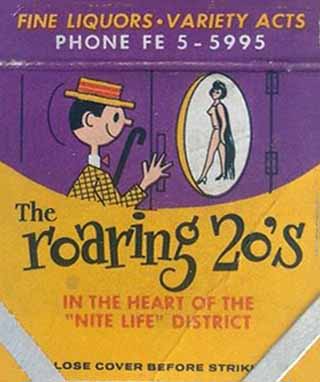
THE ROARING WEST A strange ad appeared in the paper on April 30, 1971, touting a club called The Roaring West, “formerly the Roaring 20’s.” The entertainment was Pat Starr and the Country Gentlemen. Another one appeared on May 1, and the ad on May 6 said that the Leathermen and Marie Babin were coming on May 10. What was that about? Some experiment that anticipated “Urban Cowboy” by ten years? Whatever happened, the club went back to being the good ol’ Roaring 20’s really quick.
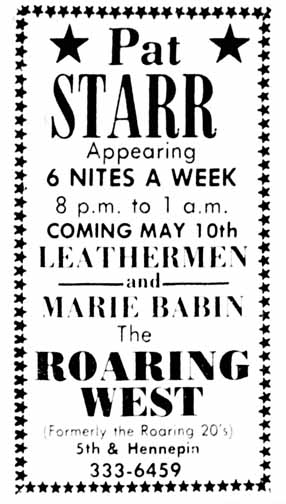
Minneapolis Star, May 6, 1971
There doesn’t seem to be any activity at the address after March 1981. But there’s this online from Curt Anderson:
I was the owner of the Roaring 20’s from 1974 through 1984 when it closed. I was in the 20’s every night for 10 years. After 84 I went on the lam for four years until I was caught in Florida. I went to trial in Minneapolis and received 20 years. I got out in 2000 and am in New York City where I am in business for myself. No – Not the bar business!
A demolition permit was approved for this second Hale Block on March 13, 1986.
